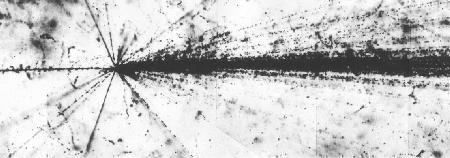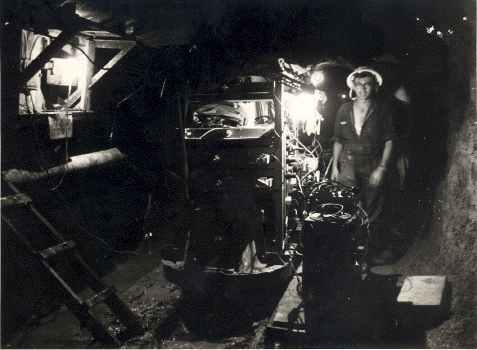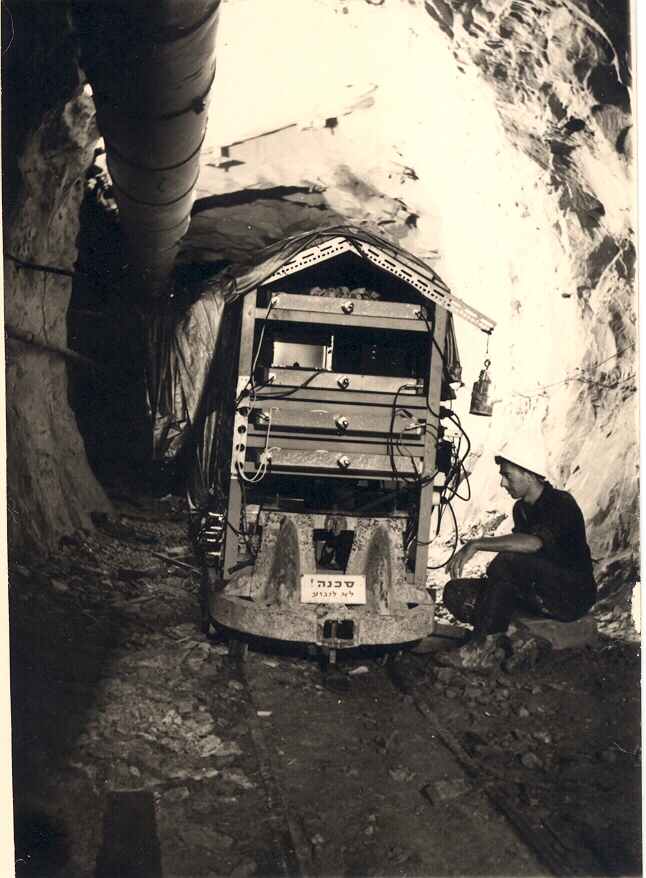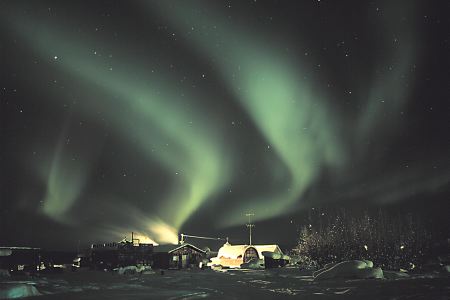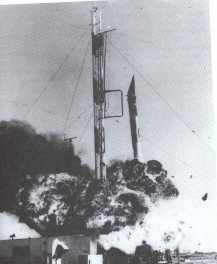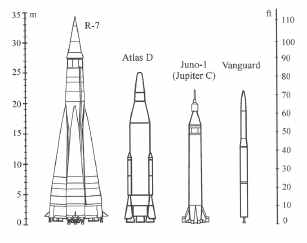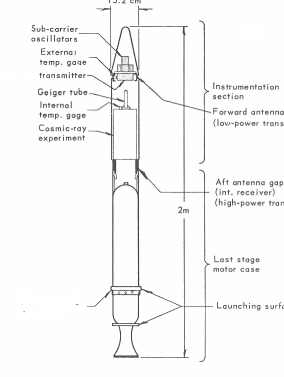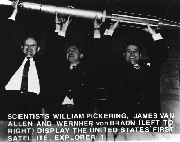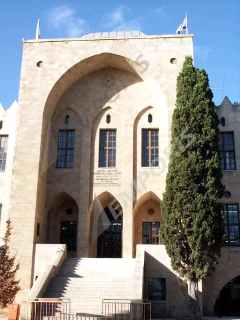 Before coming here I wondered-- what can one talk about? So many
different subjects exist in space research, each enough for a full
talk. One cannot cover more than a very small part.
I gave my host Horacio Chavéz some suggestions, but in the end we
decided I should tell about my own career. I will try.
Before coming here I wondered-- what can one talk about? So many
different subjects exist in space research, each enough for a full
talk. One cannot cover more than a very small part.
I gave my host Horacio Chavéz some suggestions, but in the end we
decided I should tell about my own career. I will try.
I studied physics in Israel, in a school for engineers in Haifa (see picture). That was a time before rockets and satellites. There was astronomy, of course, but the big telescopes were far away, and my professor happened to be interested in cosmic rays. Cosmic rays are atoms flying through space, very, very fast--actually, atoms which have lost their electrons--such atoms are then called ions, and they are electrically positive. Because ions are electrically charged, electric forces can then give them extra speed, though for cosmic rays that speed is so enormous, no one had a good idea how it happened. The picture below, made through a microscope, shows what happens when one collides with an atom in photographic emulsion. (That was one way for studying them--balloons carried the photographic plates, high in the atmosphere). Today we believe they come from supernova explosions, big exploding stars. Magnetic forces can make such ions move along curves or even circles. With the slowest cosmic rays, the magnetic force of the earth is just big enough to curve their path, though it takes 1000s of kilometers.
But the fastest ones have much more energy. When they collide with atoms in the atmosphere, the fragments not only go through all the thickness of the air, but continue hundreds of meters underground.
That is where I did my doctoral work, underground. A company was digging a tunnel, and they let me put an experiment in part of the tunnel, while they worked in other parts. Luckily, cosmic rays are not dangerous, because there are not many. We get about as much energy from them as from starlight. Of course, the universe produces a lot of starlight--stars are distant suns, after all. If stars give off as much energy in very fast atoms as they give in visible light, that could be dangerous. But as I said, we now know most stars are safe--only the exploding ones are the ones to stay away from.
When I was a student, it was realized that our Sun also sometimes produced a kind of cosmic rays, slower ones, in explosions near big sunspots. It did not happen often--maybe once a year, for half an hour. Astronauts flying to Mars some day might need extra shielding from such events. Sunspot explosions could also change the magnetic force of the Earth--by maybe 1%, for a day--also reduce the number of cosmic rays--for a few days, by a few percent. No big changes. But space is big, so these were big phenomena, with a lot of energy, making them interesting. People also knew about "northern lights" or the polar aurora. In Canada and Alaska, they are not unusual, but after sunspot eruptions, you can sometimes see them for a few hours even in Europe and the United States, because the distant magnetic field of the Earth (which controls such phenomena) is very distorted. Very rarely do they reach Mexico! No one understood how they were made. All this suggested to me that there were interesting things happening in space.
IGY
Russia--the Soviet Union--also announced a plan to build a satellite, but the United States thought it was just propaganda. And there existed one more interest. Werner Von Braun, a rocket expert working for the US army, asked for permission to launch a satellite, using a combination of big military rockets. In the war, Von Braun built rockets for Nazi Germany, which used them to bomb England. That was work for an enemy, but America hired him anyway, because they needed rocket experts. Von Braun was told--no, he could not launch a satellite, because there already existed an official project. But unofficially he put together some big military rockets which could launch a small satellite, and Professor Van Allen of the University of Iowa--he died 2 months ago, at age 91--built for it instrument to measure cosmic rays from orbit-- a small tube, a "Geiger counter" to count how many cosmic ray particles hit it, each hit produced a signal, and you could count those signals. Sputnik and Explorer 1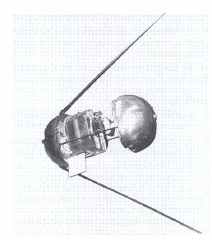 So it was a great shock to America, when in October 1957,
the Soviet Union did launch a satellite--Sputnik 1. "Sputnik" in
Russian means satellite, and it was quite big (the picture shows it
opened up to show what was inside). A month later Sputnik 2 was launched, with a dog named "Laika", which lived
for a while in orbit, showing life could survive flying through space.
So it was a great shock to America, when in October 1957,
the Soviet Union did launch a satellite--Sputnik 1. "Sputnik" in
Russian means satellite, and it was quite big (the picture shows it
opened up to show what was inside). A month later Sputnik 2 was launched, with a dog named "Laika", which lived
for a while in orbit, showing life could survive flying through space.
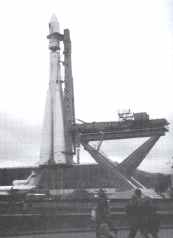
Both Sputniks were launched by a huge rocket (see picture) designed by Sergei Koralyov (Korolev). I was a student, and it was very exciting. Sputnik was supposedly transmitting "beep-beep" signals, and I took a radio out from the laboratory into the yard, with a long antenna, and tried to listen for them. I discovered there was so much beeping on the radio--from airplanes, from ships--that I could not tell if any came from Sputnik. Probably I never heard the real signal. America tried to launch "Vanguard" in December 1957, but the launch failed, the rocket rose a little, lost power, fell down and burned (see picture). Today we realize that a rocket may take a few seconds to reach full power, and use clamps to hold it down until that happens. If you watch a launch of the space shuttle, note that the announcer first says "ignition", and that is when the rocket engines begin to fire. Only a little later you hear "lift-off! ", which is when the clamps open and the rocket starts to rise. But the "Vanguard" people in 1957 did not know enough to use clamps. The Russian rocket was much, much bigger than that of "Vanguard" (see picture below).
. Sputnik 1 caused a huge shock in the United States. An illusion was broken, the illusion that the United States held first place in space, with Russia far behind. The government quickly told Von Braun to go ahead and launch his satellite, and because he was ready, it took less than 2 months before it was done. The satellite was called "Explorer 1" (the rocket was the "Jupiter C" in the picture) and it went up at the end of January 1958.
Van Allen's satellite was supposed to have a tape recorder --but that part was not yet ready. So all that could be measured were a few minutes of cosmic ray counts, whenever the satellite passed over a receiving station. Sometimes these counts were just what was expected, about 20 counts per second. Sometimes, maybe, there were more. But at other times, no counts were measured at all. It was not that the instrument was broken--it later became normal again, and then again came a time with zero counts. It made no sense.
|
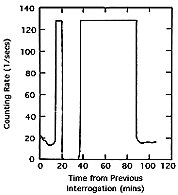 |
| Trace of counting rate of Explorer 3 |
When the satellite was at low altitude, all it counted were cosmic rays. Then the number of counts per second started climbing, to the maximum that could be recorded, 128 counts per second (it was a binary count). Still later it suddenly dropped to zero, and stayed at zero as "Explorer 3" went through the highest part of its orbit. As it came down from there, everything went through the same stages in reverse order, down to the normal rate of cosmic rays.
Obviously, there were a lot of extra particles at higher altitudes, in addition to cosmic rays. In the highest parts of the orbit they were so many, that the counter stopped working. A counter in the laboratory also behaved like this--too much radiation, and you got nothing.
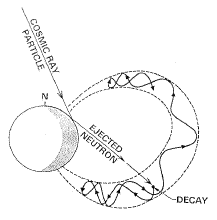 So there was a lot of radiation in space near Earth, fast particles,
like cosmic rays. (Sputnik did not find them, because it went below the
belt. The astronauts on the space station are also safe, because they
stay low down. Apollo astronauts going to the Moon had to go through
the radiation, but they did so quickly and did not get sick.) By that
time people knew that the magnetic force of the Earth could trap protons and electrons. (We call any space where magnetic forces exist "magnetic field" and I will use that name from here on.) But if it is hard to leave a magnetic trap, it is equally hard to enter it!
So there was a lot of radiation in space near Earth, fast particles,
like cosmic rays. (Sputnik did not find them, because it went below the
belt. The astronauts on the space station are also safe, because they
stay low down. Apollo astronauts going to the Moon had to go through
the radiation, but they did so quickly and did not get sick.) By that
time people knew that the magnetic force of the Earth could trap protons and electrons. (We call any space where magnetic forces exist "magnetic field" and I will use that name from here on.) But if it is hard to leave a magnetic trap, it is equally hard to enter it!
It turned out that cosmic rays were responsible: they could not get trapped themselves, but when they hit atoms of the atmosphere, they produced fragments (neutrons) which sometimes changed (something like radioactivity), and the change allowed them to stay trapped.
Of course, to a student, this all sounded very, very exciting. So after I finished my studies and got my doctorate, I came to a university in the USA in 1959 to work with one of the experts--actually, with Fred Singer, the man who first published the explanation of the lower radiation belt. Then in 1961 I changed to work with NASA, And stayed there 40 years (also, I got married, and this has lasted 45 years so far).
By that time a lot more was discovered. First of all, the radiation belt discovered by Explorer 1 was very strong, but also very small. It did not go far into space. But in addition, satellites also found a much larger "outer radiation belt" outside it, extending something like 2-3 Earth diameters away. Its particles had much less energy, but it covered much more space. It was not produced by cosmic rays, but by the Sun.
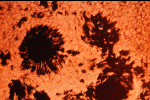 |
| Sunspot group. High Resolution here |
The Sun, of course, is what makes life on Earth possible--it keeps us warm and creates our weather. The heat for this is made near the center of the Sun--which is very, very hot, and has very high pressure, a situation where nuclear energy can be produced from hydrogen. We on Earth do not know how to get energy this way--people have tried, but it is hard to get so much heat and pressure in a laboratory.
But as the heat moves out from the center of the Sun, the temperature cools down, and at the surface it is only about 6000 degrees centigrade--hot enough to melt any material we know, but for the Sun, it is cool. Scientists can tell that temperature very accurately, from the color of the Sun.

But suppose you go higher up, into the outer atmosphere of the Sun, called "Corona." You can see the corona during a total eclipse of the Sun, and I think some tens of years ago, one happened here in Mexico. The picture on the left shows the corona, but let me warn you here--it was produced with the help of all sorts of photographic tricks, do not expect anything so spectacular if you yourself watch a total eclipse. The corona is not very dense--its usual density is less than that of a laboratory vacuum--but it is very, very hot. About a million degrees. This was found 60 years ago, and even today, no one understands how this happens. Maybe the magnetism of the Sun plays a role--there is a lot of magnetism in sunspots, and some in other parts of the Sun, too.
Whatever it is, the corona is too hot be held by the gravity of the Sun. Eugene Parker in 1958 predicted it should stream away in all directions, as a "solar wind", and a few years later, in 1961-2, satellites found that such a solar wind existed and filled interplanetary space.
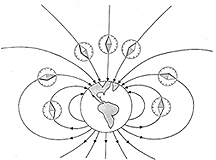
The solar wind is stopped by the magnetic field of the Earth, which creates around Earth a region of complicated electric currents, called the "Magnetosphere." That is what I have been working on since about 1965--the magnetosphere. It is the outer magnetic field of the Earth, and we describe it by lines which give the direction of the compass needle--so called magnetic field lines.
Here you can see the magnetic field lines of the Earth. They are a good way of describing the magnetic field, because they also control what is happening to the ions and electrons inside it.
Any ion or electrons is guided along field lines, and spirals around them. The result is it can stay trapped--as if the field line were a string, and the ion or electron is a little ring around the string. It does not fall off the end of the string, because when it gets close to Earth, the stronger magnetic forces near Earth push it back. That is the outer radiation belt.
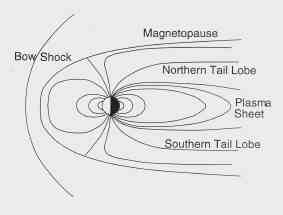
The solar wind also shapes the field lines--pushing them in on the side of the Sun, and pulling them away on the opposite side, the night side, where there exists a long magnetic tail
And the solar wind provides the energy for the polar aurora, the lights we see sometimes in the sky--not in Mexico, but in Canada and Alaska, close to the magnetic pole. Some people call them the "northern lights. " They look green, and like flames in a fire, some get bright while others get weak, it is a continuing change.
When I started with NASA, people believed they came from the outer radiation belt, that electrons were leaking out of the ends, that not all of them were completely trapped.
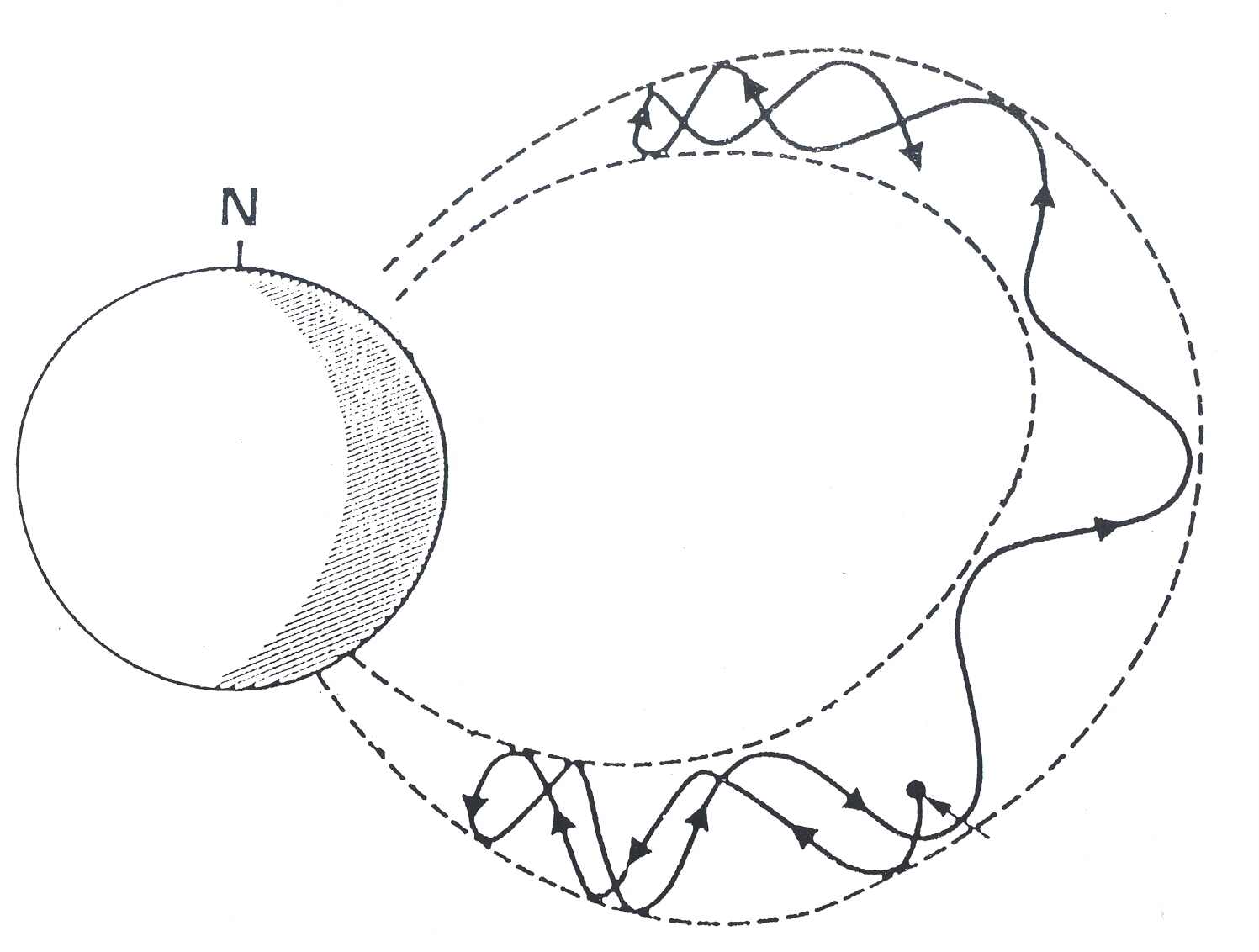
But it later turned out that this is not so--there are too many such electrons coming out, the aurora is much too bright. We instead believe that the solar wind drives electric currents from space into the high atmosphere--and those currents push electrons of the aurora out of the ends of the magnetic trap. The currents enter the polar region on its east side, flow through the high atmosphere (the "ionosphere" which conducts electricity) and then return again to space in the west, and the electrons of the aurora help carry them. And when such electrons hit atoms in the atmosphere--mainly oxygen--light is produced. A little like neon lights.
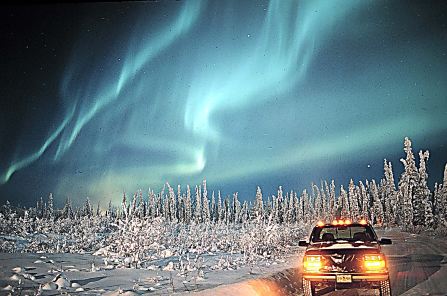 Neon lights have the color of neon, or of gases added to neon. The aurora gives light of oxygen--green
in lower levels, about 100 kilometers, red higher up, say 200
kilometers. If you go to Alaska, you may see it--but don't go in the
tourist season, in summer, because it never gets dark enough to see
aurora (the aurora is there, but you won't see it in the daytime). Go
in October or later--it may be very cold, but you have a better chance.
Neon lights have the color of neon, or of gases added to neon. The aurora gives light of oxygen--green
in lower levels, about 100 kilometers, red higher up, say 200
kilometers. If you go to Alaska, you may see it--but don't go in the
tourist season, in summer, because it never gets dark enough to see
aurora (the aurora is there, but you won't see it in the daytime). Go
in October or later--it may be very cold, but you have a better chance.
Satellites of course can also see the aurora through special filters, that let through only the right colors. The picture below shows the whole northern "polar cap" of the Earth, with the aurora going a full circle around the magnetic pole (the map and the coloring were added by computer). You need be a certain distance from the pole to get aurora: at the pole itself auroras are very rare, and are often of a different kind.
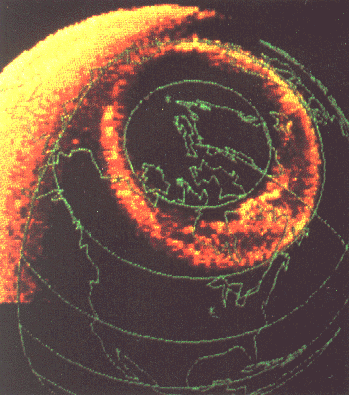
To drive those currents you need a voltage. In 1976, a satellite of the United States air force observed those voltages--about 1/3 the voltage in a TV tube, which emits light from a screen, just as the aurora does from the upper atmosphere (or else, about the voltage of the old black-and-white TV). The voltage shoots negative electrons down, and oxygen ions, that is, atoms which are positive after losing an electron, come shooting up, because electric forces which shoot negative electrons in one direction also shoot positive particles in the opposite direction. The oxygen "beams" have also been measured.
My work to a large extent has been to try describe the electric currents associated with all this. Some currents create the boundary on the side of the sun, some currents create the tail on the night side, some currents create the aurora, and some are carried by the trapped radiation belt. Like the belt, those currents go around the earth like a ring, so this is called the ring current. For the last 15 years I have been working with a Russian colleague, who collects data from American satellites--there is a lot of cooperation in science, no matter what the politicians do. Unfortunately , he soon goes back to Russia, where his daughter and grand-daughter live.
I have retired 5 years ago, and since that time, have tried to tell that story through the internet--and my friend here in Anahuac, Horacio Chavéz, has been one of the people helping translate it into Spanish--also material on astronomy, space flight, magnetism and physics. You will find links to all this on http://www.phy6.org/readfirst.htm.
There is much more in space research than can be put in one talk--but you will find a lot of it linked from the above address, if you have the time to read it all. We are still discovering new things in space--and flying to the Moon and planets is not the only way to make discoveries. There exist many interesting phenomena which we still do not understand. People who talk about space on TV often know too little and end up telling generalities. If you can, read what scientists write about these things. Scientists know the real story--and if sometimes they write "We do not know--yet, " that may be the most interesting part.
Indeed, more scientists should help tell this story. There used to be in Mexico City a dedicated woman scientist, Silvia Bravo, who put out a web-magazine "Skylab", six times a year, full of interesting articles, in Spanish, anyone with a web connection could read them. Then in the year 2000 she suddenly died, and the magazine died with her. It is still on the web--but only the old articles, not new ones. Maybe it is time for someone to start it again!
For now, I hope I have said enough. If you have questions, I will gladly answer them--today, or during my time here--or afterwards, by e-mail.
Thank you
